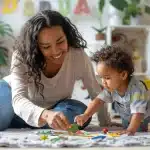Teaching digraphs and blends can be tricky, especially for young learners. Many educators find it challenging to keep students engaged while learning these important phonics concepts.
But don’t worry! With the right approach, you can make this learning process both effective and enjoyable.
In this blog post, we’ll explore 21 fun activities that will help your students master digraphs and blends.
These hands-on, interactive exercises are designed to capture your students’ attention and reinforce their understanding of these crucial reading skills.
Get ready to transform your phonics lessons into exciting adventures that your students will look forward to!
What are Digraphs and Blends?
Before diving into our fun activities, let’s clarify what digraphs and blends are.
Digraphs are two letters that combine to create one new sound. For example, in the word “ship,” the ‘sh’ makes a single sound that’s different from the ‘s’ and ‘h’ individually.
Blends, on the other hand, are two or more letters where you can hear each letter’s sound. In “frog,” you can hear both the ‘f’ and ‘r’ sounds at the beginning.
By mastering these concepts, children build a strong foundation for reading and spelling. Our activities will help reinforce these distinctions in engaging ways.
Fun Activities to Teach Digraph
1. Digraph Picture Sorts
This hands-on activity helps children identify and categorize words with different digraphs, reinforcing their understanding of these special letter pairs.
Materials & Players
- 1-4
- Picture cards of words containing various digraphs
- Sorting mats or containers labeled with different digraphs
How to Play
- Spread out the picture cards face-up on a table.
- Place the sorting mats or containers nearby, each labeled with a different digraph.
- Have players take turns picking a card and saying the word aloud.
- The player then identifies the digraph in the word and places the card in the corresponding sorting mat or container.
- If playing competitively, the player with the most correct sorts at the end wins.
- For a cooperative version, players can work together to sort all the cards correctly.
2. Bottle Cap Digraph Centers
This creative activity uses everyday items to help children build digraph words, making learning both fun and tactile. Kids match bottle cap letters to picture cards, improving their spelling and sound recognition skills.
Materials & Players
- 1-4
- Recycled bottle caps
- Permanent markers or letter stickers
- Picture cards with digraph words and corresponding images
- Small bags or containers (optional)
How to Play
- Label each bottle cap with a letter using a marker or sticker.
- Lay out the picture cards on a table or mat.
- Organize the labeled bottle caps for easy access.
- Explain that children need to match the picture with the correct word using the bottle caps.
- Have each child pick a picture card and identify the word.
- The child uses the bottle caps to spell out the word beneath the picture.
- Encourage saying the word aloud, focusing on the digraph sound.
- Check the completed word against the card for accuracy.
3. Mystery Bag Digraph Guessing
This engaging activity combines sensory exploration with digraph learning, as children try to guess hidden objects based on verbal clues, focusing on words with digraphs.
Materials & Players
- 2-10
- A non-transparent bag
- Various small objects with names containing digraphs (e.g., shell, brush, chair)
- List of clues for each object
How to Play
- Fill the bag with objects that have digraphs in their names.
- Gather the players in a circle or small group.
- Choose one player to be the first ‘clue-giver.’
- The clue-giver selects an object from the bag without showing it to others.
- They provide clues about the object, emphasizing the digraph sound in the word.
- Other players take turns guessing the object.
- The first player to guess correctly becomes the next clue-giver.
- Continue until all objects have been guessed or a set time limit is reached.
4. Digraph Freeze
This lively activity gets children moving while sharpening their listening skills for digraph sounds. It’s a fun way to reinforce digraph recognition in an energetic, whole-body learning experience.
Materials & Players
- 5-20
- Open space in the classroom
- List of words with and without the target digraph
- Optional: Music player for background music
How to Play
- Clear an open space in the classroom for children to move around.
- Explain that children will walk (or dance if using music) when they hear words without the target digraph.
- Tell them to freeze when they hear a word containing the target digraph.
- Start the activity by clearly calling out words at regular intervals.
- Children move or freeze based on the words they hear.
- If a child moves during a digraph or freezes for a non-digraph word, they sit out until the next round.
- The last player standing wins the round.
- For an added challenge, switch the target digraph mid-game.
5. Digraph Hopscotch
This outdoor activity combines physical movement with digraph recognition, making learning fun and active. Children hop through a hopscotch grid while identifying and pronouncing digraph sounds.
Materials & Players
- 2-6
- Chalk
- Outdoor paved area or large floor space
- List of digraphs to include in the hopscotch grid
How to Play
- Draw a hopscotch grid on the ground, writing a different digraph in each square.
- Line up the players at the starting point.
- The first player tosses a small object (like a stone) onto the grid.
- The player hops through the grid, skipping the square with the object.
- When landing on a square, the player must say a word that includes the digraph written there.
- If the player can’t think of a word, their turn ends, and they go to the back of the line.
- If successful, the player continues until they complete the course or make a mistake.
- The next player then takes their turn.
- The first player to successfully complete the entire grid wins.
6. Spin a Word: Digraph Edition
This interactive game combines chance and skill as children use a spinner to create and read words containing digraphs. It’s a fun way to practice word-building and reading skills while reinforcing digraph recognition.
Materials & Players
- 2-4
- A spinner divided into sections (with different beginning sounds, digraphs, and ending sounds)
- Whiteboard or paper for each player
- Dry-erase markers or pencils
How to Play
- Give each player a whiteboard or sheet of paper and a writing tool.
- Explain that players will use the spinner to create words with digraphs.
- The first player spins for a beginning sound, then for a digraph, and finally for an ending sound.
- The player writes down the word created by combining these sounds.
- They then read the word aloud. If it’s a real word, they get a point. If it’s a nonsense word, they should still try to read it.
- Other players can challenge if they think the word is read incorrectly.
- Play moves to the next player.
- Continue for a set number of rounds or until a player reaches a target score.
- The player with the most points at the end wins.
7. Digraph Clip Cards
This hands-on activity helps children match digraphs to pictures, improving their visual recognition of digraphs and enhancing fine motor skills. It’s a simple yet effective way to reinforce digraph sounds and their spellings.
Materials & Players
- 1-4
- Set of cards with pictures and multiple digraph options
- Clothespins
- Optional: Self-checking system on the back of cards
How to Play
- Spread out the digraph clip cards on a table or floor.
- Provide each player with a set of clothespins.
- Players select a card and look at the picture.
- They determine which digraph correctly matches the picture.
- Players clip the clothespin onto the card next to the correct digraph.
- If playing alone, the child can flip the card to check their answer.
- If playing with others, take turns checking each other’s answers.
- For group play, the player with the most correct clips at the end wins.
- To increase difficulty, set a time limit for completing a certain number of cards.
8. Phonics Fluency Puzzles (Digraph Focused)
This engaging activity combines problem-solving skills with digraph recognition, helping children build fluency in identifying and using digraphs through a fun puzzle format.
Materials & Players
- 1-3
- Set of puzzle pieces, each featuring a digraph
- Puzzle base or mat with outlines for the pieces
- Timer (optional)
How to Play
- Lay out all the puzzle pieces face up on a table.
- Place the puzzle base or mat nearby.
- Explain that each puzzle piece represents a digraph sound.
- The child selects a puzzle piece, says the digraph sound, and a word containing that digraph.
- They then place the piece in its correct position on the puzzle base.
- If playing alone, the child continues until the puzzle is complete.
- For multiple players, take turns selecting and placing pieces.
- If a player can’t think of a word with the digraph, they miss a turn.
- The game ends when the puzzle is completed.
9. Interactive Phonics Notebooks
This hands-on activity helps children organize and practice their digraph knowledge through personalized notebooks. It’s an excellent way to reinforce learning and create a reference tool for ongoing study.
Materials & Players
- 1 player
- Notebooks or binders (one per child)
- Printed worksheets with digraph activities
- Scissors and glue
- Colored pencils or markers
- Stickers (optional)
How to Play
- Provide each child with a notebook and a set of digraph activity sheets.
- Explain that they will be creating their own phonics reference book.
- Start with a section for each digraph you’ve been studying.
- Have children cut out and glue digraph headers at the top of each page.
- Under each header, children complete activities such as:
– Writing words that contain the digraph
– Drawing pictures of objects with the digraph sound
– Sorting words into categories based on their digraphs
– Creating sentences using words with the target digraph - Encourage children to decorate their pages to make them visually appealing.
- Periodically review the notebooks, adding new sections as more digraphs are learned.
- Use the notebooks as a reference during other reading and writing activities.
10. ASL Digraphs
This unique activity introduces American Sign Language (ASL) to teach digraphs, adding a kinesthetic learning dimension. It helps children associate physical movements with digraph sounds, enhancing memory and understanding.
Materials & Players
- 2-10
- ASL alphabet chart
- Flashcards with digraphs and corresponding ASL signs
- List of words containing various digraphs
How to Play
- Introduce the ASL alphabet chart to the children.
- Teach the ASL signs for common digraphs (like ‘ch’, ‘sh’, ‘th’).
- Show a flashcard with a digraph and its ASL sign.
- Have children practice the sign while saying the digraph sound.
- Call out a word containing a digraph.
- Children identify the digraph in the word and make the corresponding ASL sign.
- For group play, have children take turns being the ‘caller.’
- To increase difficulty, ask children to spell entire words using ASL, emphasizing the digraph signs.
Fun Activities to Teach Blends
11. Blending with Large Letter Cards
This interactive activity uses oversized letter cards to help children visualize and physically manipulate blends, making the concept more tangible and easier to understand.
Materials & Players
- 3-10
- Large letter cards (including individual letters and common blends)
- Open floor space or large table
- List of words containing blends
How to Play
- Spread out the large letter cards on the floor or table.
- Divide children into small groups of 2-3.
- Call out a word containing a blend (e.g., “frog”).
- Each group selects the appropriate letter cards to form the word.
- One child holds the blend cards (‘fr’), while others hold the remaining letters.
- The group arranges themselves to spell out the word.
- Once arranged, the group says the word aloud, emphasizing the blend.
- The first group to correctly form and pronounce the word earns a point.
- Continue with different words, rotating roles within the groups.
- The group with the most points at the end wins.
12. Blend Bingo
This engaging adaptation of the classic Bingo game helps children recognize and match blend words with their corresponding images, reinforcing both visual and auditory recognition of blends.
Materials & Players
- 2-15
- Bingo cards with pictures of blend words
- Calling cards with blend words
- Markers or chips for covering spaces
- A container for the calling cards
How to Play
- Give each player a Bingo card and markers.
- Shuffle the calling cards and place them in the container.
- The caller draws a card and reads the blend word aloud.
- Players look for the corresponding picture on their Bingo card.
- If they have the picture, they cover it with a marker.
- The caller continues drawing and reading words.
- Players call out “Bingo!” when they have covered a complete row, column, or diagonal.
- The caller checks the winning card for accuracy.
- If correct, that player wins the round.
13. Beat the Clock with Blends
This fast-paced activity challenges children to quickly recognize and read words with blends, improving their fluency and speed in decoding blend words.
Materials & Players
- 1-15
- List of words containing blends
- Timer or stopwatch
- Whiteboard or large paper to record scores
- Optional: Small prizes for motivation
How to Play
- Prepare a list of blend words appropriate for the children’s reading level.
- Set a time limit (e.g., 1 minute) and explain the goal: to read as many words correctly as possible.
- Show the first word to the player or group.
- Start the timer as the child begins reading the words aloud.
- If a word is read incorrectly, quickly provide the correct pronunciation and move on.
- Count the number of words read correctly when the time is up.
- Record the score on the whiteboard.
- For multiple players, take turns and compare scores.
- To increase difficulty, use longer words or decrease the time limit.
- Play multiple rounds, encouraging children to beat their own scores.
14. Human Dominoes with Blends
This active, whole-body learning game turns children into living dominoes, reinforcing their understanding of blends through movement and social interaction.
Materials & Players
- 6-20
- Large cards with blend words on one half and pictures on the other
- Open space for children to move around
- Optional: Soft background music
How to Play
- Give each child a card with a blend word on one side and a picture on the other.
- Choose one child to start by standing and showing their card.
- Other children look at their cards to see if they have a matching word or picture.
- The child with the match stands next to the first child, connecting like dominoes.
- This continues with each new child adding to the line.
- If a child can’t find a match, they say “pass” and the next child tries.
- When placing their card, children must say the blend word aloud.
- The game ends when all children are connected in the domino line.
15. Blend Mystery Bag
This engaging activity combines sensory exploration with blend recognition, as children try to guess hidden objects based on verbal clues, focusing on words with blends.
Materials & Players
- 2-10
- A non-transparent bag
- Various small objects with names containing blends (e.g., frog, brush, clock)
- List of clues for each object
How to Play
- Fill the bag with objects that have blends in their names.
- Gather the players in a circle or small group.
- Choose one player to be the first ‘clue-giver’.
- The clue-giver selects an object from the bag without showing it to others.
- They provide clues about the object, emphasizing the blend sound in the word.
- Other players take turns guessing the object.
- The first player to guess correctly becomes the next clue-giver.
- Encourage players to repeat the blend sound when they guess the word.
- Continue until all objects have been guessed or a set time limit is reached.
16. Phoneme Blending with Manipulatives
This hands-on activity uses physical objects to represent individual sounds, helping children visualize and manipulate the process of blending sounds into words.
Materials & Players
- 1-4
- Colored blocks, tiles, or tokens (one color for single letters, another for blends)
- Word cards with blend words
- Small trays or mats for each player
How to Play
- Assign a color for single letter sounds and another for blends (e.g., blue for single sounds, red for blends).
- Give each player a set of blocks and a tray or mat.
- Show a word card with a blend word (e.g., “frog”).
- Players place a red block for the blend (“fr”) and blue blocks for the remaining sounds.
- Guide players to touch each block as they say its sound, then sweep their hand under all blocks to blend the sounds together.
- Players say the complete word after blending.
- For group play, have children take turns being the “word caller.”
- To increase difficulty, use longer words with multiple blends.
- For younger players, start with simpler words and fewer blocks.
Integrated Digraph and Blend Activities
17. Digraph and Blend Word Chains
This engaging activity helps children understand how changing one sound can create new words, focusing on digraphs and blends.
Materials & Players
- 2-6
- Whiteboard or large paper
- Markers
- List of digraph and blend words that can be easily changed
How to Play
- Write a starting word on the board (e.g., “ship”).
- Players take turns changing one sound to make a new word (e.g., “ship” to “chip”).
- Each new word must contain a digraph or blend.
- Continue the chain until no more words can be made.
- The player who makes the last word starts a new chain.
- Encourage players to explain the sound change they made.
- For an added challenge, set a theme for the words or use a timer.
18. A-Maze-ing Sentences (Digraphs and Blends)
This activity combines reading comprehension with maze-solving, making practice with digraphs and blends more exciting.
Materials & Players
- 1-3
- Printed mazes with sentences containing digraphs and blends at decision points
- Pencils or markers
How to Play
- Give each player a maze.
- Players start at the entrance and read the first sentence.
- Based on the sentence, they choose which path to follow.
- At each junction, they read a new sentence to decide their next move.
- Players must read each sentence aloud, emphasizing digraphs and blends.
- The goal is to reach the exit by following the correct sentences.
- For group play, take turns reading sentences and deciding as a team.
- To increase difficulty, include more complex sentences or a time limit.
- This activity encourages careful reading and decision-making while practicing digraph and blend words in context.
19. Phoneme Blending with Sound Boxes
This visual and kinesthetic activity helps children understand how sounds combine to form words, with a focus on digraphs and blends.
Materials & Players
- 1-4
- Paper with drawn sound boxes (one box per sound, with digraph/blend boxes larger)
- Small objects (e.g., buttons, pebbles)
- Word cards with digraph and blend words
How to Play
- Show a word card to the player(s).
- Players say each sound in the word, placing an object in the corresponding box.
- For digraphs or blends, place two objects in the larger box.
- After filling all boxes, players sweep their finger across the boxes, blending the sounds.
- They then say the complete word.
- For group play, take turns being the “word caller”.
- Increase difficulty by using longer words or having players write the letters in the boxes.
20. Interactive Digraph and Blend Stories
This creative activity encourages children to use digraph and blend words in context while developing their storytelling skills.
Materials & Players
- 1-4
- Paper and pencils
- List of digraph and blend words
- Art supplies (crayons, markers, etc.)
How to Play
- Provide each player with paper, pencils, and a list of digraph and blend words.
- Players choose a set number of words from the list (e.g., 5-10).
- They then create a short story using all their chosen words.
- Encourage players to illustrate their stories.
- Once finished, players share their stories, emphasizing the digraph and blend words.
- For group play, create a collaborative story, with each player adding a sentence.
- To increase difficulty, set a theme for the stories or add a time limit.
21. Digraph and Blend Fluency Passages
This activity focuses on improving reading fluency with texts that heavily feature digraphs and blends.
Materials & Players
- 1-2
- Short passages rich in digraph and blend words
- Timer
- Tracking sheet for recording progress
How to Play
- Give the player a passage to read.
- Set a timer for one minute.
- The player reads aloud as much of the passage as they can in one minute.
- Count the number of words read correctly, noting any digraph or blend words.
- Record the score on the tracking sheet.
- Include comprehension questions about the passage.
- For paired reading, have players take turns reading and timing each other.
- Repeat with the same passage to see improvement over time.
- Gradually introduce more challenging passages.
Conclusion
These amazing activities offer a variety of engaging ways to teach digraphs and blends to young learners.
By incorporating games, physical movement, and creative exercises, you can make the learning process both fun and effective.
These activities not only help children recognize and use digraphs and blends but also improve their overall reading and writing skills.
Remember, every child learns differently, so feel free to adapt these activities to suit your students’ needs. The key is to keep the learning experience enjoyable and interactive.
Why not start by trying one or two of these activities in your next lesson?
You’ll likely see increased engagement and faster progress in your students’ phonics skills.
Happy Teaching!











